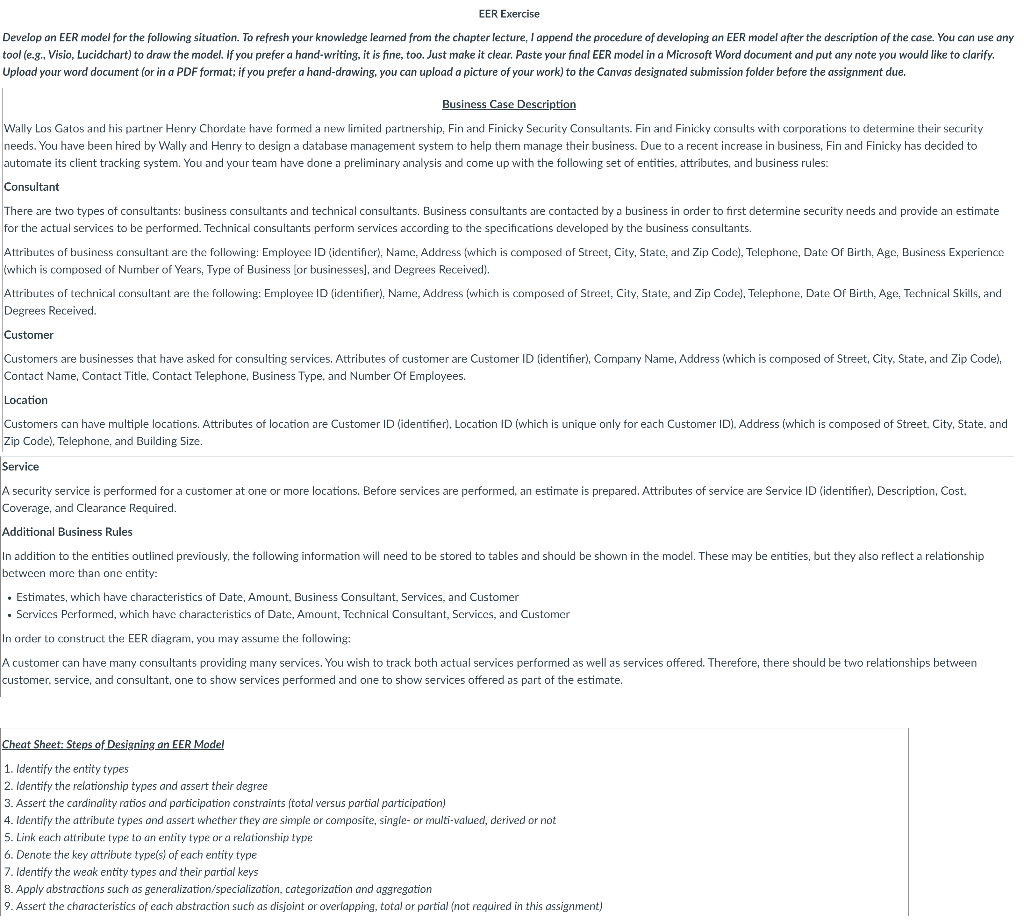
Develop an EER model for the following situation. To refresh your knowledge learned from the chapter lecture, I append the procedure of developing an EER model after the description of the case. You can use any tool (e.g. Visio, Lucidchart) to draw the model. If you prefer a hand-writing, it is fine, too. Just make it clear. Paste your final EER model in a Microsoft Word document and put any note you would like to clarify. Upload your word document (or in a PDF format; if you prefer a hand-drawing, you can upload a picture of your work) to the Canvas designated submission folder before the assignment due. Business Case Description Wally Los Gatos and his partner Henry Chordate have formed a new limited partnership, Fin and Finicky Security Consultants. Firl and Finicky consults with corporations to determine their security needs. You have been hired by Wally and Henry to design a database management system to help them manage their business. Due to a recent increase in business, Fin and Finicky has decided to automate its client tracking system. You and your team have done a preliminary analysis and come up with the following set of entities, attributes, and business rules: Consultant There are two types of consultants: business consultants and technical consultants. Business consultants are contacted by a business in order to first determine security needs and provide an estimate for the actual services to be performed. Technical consultants perform services according to the specifications cleveloped by the business consultants. Attributes of business consultant are the following: Employee ID (identifier), Name, Address (which is composed of Street, City, State, and Zip Code), Telephone, Date Of Birth, Age, Business Experience. (which is composed of Number of Years, Type of Business [or businesses], and Degrees Received], Attributes of technical consultant are the following: Employee ID (identifier), Name, Address (which is composed of Street, City, State, and Zip Code), Telephone, Date Of Birth, Age, Technical Skills, and Degrees Received. Customer Customers are businesses that have asked for consulting services. Attributes of customer are Customer ID (identifier), Company Name, Address (which is composed of Street, City, State, and Zip Code), Contact Name, Contact Title, Contact Telephone, Business Type, and Number Of Employees. Location Customers can have multiple locations. Attributes of location are Customer ID (identifier), Location ID (which is unique only for each Customer ID). Address (which is composed of Street, City, State, and Zip Code), Telephone, and Building 5ize. Service A security service is performed for a customer at one or more locations. Before services are performed, an estimate is prepared. Attributes of service are Service ID (identifier), Description, Cost. Coverage, and Clearance Required. Additional Business Rules In addition to the entities outlined previously, the following information will need to be stored to tables and should be shown in the model. These may be entities, but they also reflect a relationship between more than one entity: - Estimates, which have characteristics of Date, Amount, Business Consultant, Services, and Customer - Services Performed, which have characteristics of Date, Amount, Technical Consultant, Services, and Customer In order to construct the EER diagram, you may assume the following: A customer can have many consultants providing many services. You wish to track both actual services performed as well as services offered. Therefore, there should be two relationships between customer. service, and consultant, one to show services performed and one to show services offered as part of the estimate. Cheat Sheet: Steps of Designing on EER Model 1. Identify the entity types 2. Identify the relationship types and assert their degree 3. Assert the cardinality ratios and porticipation constraints (total versus partial participation) 4. Identify the attribute types ond assert whether they ore simple or composite, single- or multi-valued, derived or not 5. Link each attribute type to an entity type or a relationship type 6. Denote the key attribute type(s) of each entity type 7. Identify the weak entity types and their partial keys 8. Apply abstractions such as generalization/specializotion, categorization and aggregation 9. Assert the characteristics of each abstraction such as disjoint or overiapping, total or portial (not required in this assignment)







